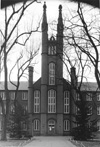Collegiate Gothic Style 1890 - 1940
History
The Collegiate Gothic Revival style is an early 20th century adaptation of the 19th century Gothic Revival style to serve a specific function, educational buildings. The Gothic Revival style, which flourished from the period of 1830 through 1890 in the United States, was often chosen for churches and institutional buildings due to its impressive, medievally-inspired form. In the early 20th century the Gothic Revival style reappeared for an appropriate choice for both university and secondary school buildings. Prominent universities such as Boston College, Yale, Duke, and Princeton employed the Collegiate Gothic Revival style in this period to create an atmosphere of respected antiquity.
In the 1920s and 30s, many new public and private schools were built in Pennsylvania as a result of changes in educational policy. These new larger and more complex school buildings had specialized space design for cafeterias, gyms and technical training and were often of Collegiate Gothic style. While these designs were sometimes rather pared down versions of the more ornate forms of the style with only a few decorative details like an arched and recessed entryway or a few decorative panels, these school buildings are clearly part of the Gothic Revival tradition. Masonry construction lent a sense of permanence and substance, a fitting image for the public education system, especially as it strove for even greater academic offerings.
The Collegiate Gothic Revival style can be found throughout the state in the public and private secondary schools of cities and towns, and also on university campuses. The Philips Memorial Building at West Chester University is a noted example of this style and was built in 1927. Constructed in 1930, Bishop McDevitt High School (originally called Catholic High School) in Harrisburg is another good example of this style as seen as a private secondary school.
Common Building Types
- high schools
- colleges
- administrative buildings
Identifiable Features
- Gothic arch window and door openings
- Masonry (brick or stone) construction
- Bas relief decorative panels or plaques
- Portico or recessed porch entryway
- Buttresses
- Tracery windows
- Crenulated parapet
- Tower or spire
Photos
Click the thumbnails for larger images.




